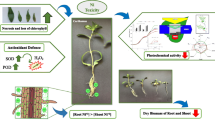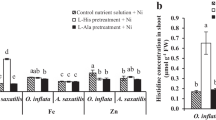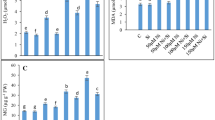Abstract
Among metals, Ni has been indicated as one of the most dangerous for the environment, and plants exposed to this metal are frequently reported to undergo a severe stress condition. In this work, the tolerance responses to different Ni concentrations at physiological and biochemical levels were evaluated in Amaranthus paniculatus L., a plant species previously characterised for their ability to phytoremove Ni from metal-spiked water. Results indicated a good metal tolerance of this plant species at environmentally relevant Ni concentrations, while clear symptoms of oxidative damages were detected at higher Ni concentrations, both in roots and leaves, by measuring lipid peroxide content. At the photosynthetic level, pigment content determination, chlorophyll fluorescence image analysis and gas-exchange parameter measurements revealed a progressive impairment of the photosynthetic machinery at increasing Ni concentrations in the solution. Regarding biochemical mechanisms involved in antioxidative defence and metal binding, antioxidative enzyme (ascorbate peroxidase, APX; catalase, CAT; guaiacol peroxidase, GPX; superoxide dismutase, SOD) activity, polyamine (PA) content, polyamine oxidase (PAO) activity and organic acid (OA) content were differently affected by Ni concentration in the growth solution. A role for GPX, SOD, PAs, and oxalic and citric acid in Ni detoxification is suggested. These results can contribute to elucidate the tolerance mechanisms carried out by plants when facing environmentally relevant Ni concentrations and to identify some traits characterising the physiological and biochemical responses of Amaranthus plants to the presence and bioaccumulation of Ni.









Similar content being viewed by others
References
Assunção AGL, Bookum WM, Nelissen HJM, Vooijs R, Schat H, Ernst WHO (2003) Differential metal-specific tolerance and accumulation patterns among Thlaspi caerulescens populations originating from different soil types. New Phytol 159:411–419
Beauchamp C, Fridovich I (1971) Superoxide dismutase improved assays and an assay applicable to acrylamide gels. Anal Biochem 44:276–287
Bhatia NP, Walsh KB, Baker AJM (2005) Detection and quantification of ligands involved in nickel detoxification in a herbaceous Ni hyperaccumulator Stackhousia tryonii Bailey. J Exp Bot 56:1343–1349
Cabanillas J, Ginebreda A, Guillén D, Martínez E, Barceló D, Moragas L, Robusté J, Darbra RM (2012) Fuzzy logic based risk assessment of effluents from waste-water treatment plants. Sci Tot Environ 439:202–210
Callahan DL, Baker AJM, Kolev SD, Wedd AG (2006) Metal ion ligands in hyperaccumulating plants. J Biol Inorg Chem 11:2–12
Cerovic ZG, Masdoumier G, Ghozlen NB, Latouche G (2012) A new optical leaf-clip meter for simultaneous non-destructive assessment of leaf chlorophyll and epidermal flavonoids. Physiol Plant 146:251–260
Chance B, Maehly C (1955) Assay of catalase and peroxidases. Meth Enzymol 11:764–775
Clemens S (2006) Toxic metal accumulation, responses to exposure and mechanisms of tolerance in plants. Biochimie 88:1707–1719
Cona A, Cenci F, Cervelli M, Federico R, Mariottini P, Moreno S, Angelini R (2003) Polyamine oxidase, a hydrogen peroxide-producing enzyme, is up-regulated by light and down-regulated by auxin in the outer tissues of the maize mesocotyl. Plant Physiol 131:803–813
de Agazio M, Zacchini M (2001) Dimethylthiourea, a hydrogen peroxide trap, partially prevents stress effects and ascorbate peroxidase increase in spermidine-treated maize roots. Plant Cell Environ 24:237–244
Dietz KJ, Baier M, Krämer U (1999) Free radicals and reactive oxygen species as mediators of heavy metal toxicity in plants. In: Prasad MNV, Hagemeyer J (eds) Heavy metal stress in plants: from molecules to ecosystems. Springer Verlag, Berlin, pp 73–97
Draźkiewicz M, Baszyński T (2005) Growth parameters and photosynthetic pigments in leaf segments of Zea mays exposed to cadmium, as related to protection mechanisms. J Plant Physiol 162:1013–1021
Gabbrielli R, Pandolfini T, Vergnano O, Palandri MR (1990) Comparison of two serpentine species with different nickel tolerance strategies. Plant Soil 122:271–277
Gajewska E, Sklodowska M (2007) Effect of nickel on ROS content and antioxidative enzyme activities in wheat leaves. Biometals 20:27–36
Gajewska E, Sklodowska M, Slaba M, Mazur J (2006) Effect of nickel on antioxidative enzymes activities, proline and chlorophyll contents in wheat shoots. Biol Plant 50:653–659
Galardi F, Corrales I, Mengoni A, Pucci S, Barletti L, Barzanti R, Arnetoli M, Gabbrielli R, Gonnelli C (2007) Intra-specific differences in nickel tolerance and accumulation in the Ni-hyperaccumulator Alyssum bertolonii. Environ Exp Bot 60:377–384
Gonnelli C, Galardi F, Gabbrielli R (2001) Nickel and copper tolerance and toxicity in three Tuscan populations of Silene paradoxa. Physiol Plant 113:507–514
Groppa MD, Tomaro ML, Benavides MP (2007) Polyamines and heavy metal stress: the antioxidant behaviour of spermine in cadmium- and copper-treated wheat leaves. Biometals 20:185–195
Handa AK, Matoo AK (2010) Differential and functional interactions emphasize the multiple roles of polyamines in plants. Plant Physiol Biochem 48:540–546
Havir EA, McHale NA (1987) Biochemical and developmental characterization of multiple forms of catalase in tobacco leaves. Plant Physiol 84:450–455
Heath RL, Packer L (1968) Photoperoxidation in isolated chloroplasts: I. Kinetics and stoichiometry of fatty acid peroxidation. Arch Biochem Biophys 125:189–198
Iori V, Pietrini F, Cheremisina A, Shevyakova NI, Radyukina N, Kuznetsov VLV, Zacchini M (2013) Growth responses, metal accumulation and phytoremoval capability in Amaranthus plants exposed to nickel under hydroponics. Water Air Soil Poll 224:1450–1459
Kováčik J, Klejdus B, Hedbavny J, Bačkor M (2009) Nickel uptake and its effect on some nutrient levels, amino acid contents and oxidative status in Matricaria chamomilla plants. Water Air Soil Poll 202:199–209
Krämer U (2010) Metal hyperaccumulation in plants. Ann Rev Plant Biol 61:517–534
Krämer U, Smith RD, Wenzel WW, Raskin I, Salt DE (1997) The role of metal transport and tolerance in nickel hyperaccumulation by Thlaspi goesingense Hálácsy. Plant Physiol 115:1641–1650
Küpper H, Kroneck PMH (2007) Nickel in the environment and its role in the metabolism of plants and cyanobacteria. In: Sigel A, Sigel H, Sigel RKO (eds) Metal ions in life sciences, vol 2. Wiley Ltd, pp31–62
Kuznetsov VV, Radyukina NL, Shevyakova NI (2006) Polyamines and stress: biological role, metabolism, and regulation. Russ J Plant Physiol 53:658–683
Llamas A, Ullrich CL, Sanz A (2008) Ni2+ toxicity in rice: effect on membrane functionality and plant water content. Plant Physiol Biochem 46:905–910
Lomozik L, Gasowska A, Bregier-Jarzebowska R, Jastrzab R (2005) Coordination chemistry of polyamines and their interactions in ternary systems including metal ions, nucleosides and nucleotides. Coord Chem Rev 249:2335–2350
Long SP (1999) Environmental responses. In: Sage RF, Monson RK (eds) C4 Plant biology. Academic, San Diego, pp 215–249
López-Bucio J, Martínez de la Vega O, Guevara-García A, Herrera-Estrella L (2000) Enhanced phosphorus uptake in tobacco transgenic plants that overproduce citrate. Nat Biotech 18:450–453
Madzhugina YG, Kuznetsov VV, Shevyakova NI (2008) Plants inhabiting polygons for megapolis waste as promising species for phytoremediation. Russ J Plant Physiol 55:410–419
Maestri E, Marmiroli M, Visioli G, Marmiroli N (2010) Metal tolerance and hyperaccumulation: cost and trade-offs between traits and environment. Environ Exp Bot 68:1–13
Maheshwary R, Dubey RS (2009) Nickel-induced oxidative stress and the role of antioxidant defence in rice seedlings. Plant Growth Regul 59:37–49
Mellem JJ, Baijnath H, Odhav B (2009) Translocation and accumulation of Cr, Hg, As, Pb, Cu and Ni by Amaranthus dubius (Amaranthaceae) from contaminated sites. J Environ Sci Health 44:568–575
Memon AR, Schröder P (2009) Implications of metal accumulation mechanisms to phytoremediation. Environ Sci Pollut Res 16:162–175
Miller G, Shulaev V, Mittler R (2008) Reactive oxygen signaling and abiotic stress. Physiol Plant 133:481–489
Nakano Y, Asada K (1981) Hydrogen peroxide is scavenged by ascorbate-specific peroxidase in spinach chloroplasts. Plant Cell Physiol 22:867–880
Palacios G, Gómez I, Carbonell-Barrachina A, Navarro Pedreño J, Mataix J (1998) Effect of nickel concentration on tomato plant nutrition and dry matter yield. J Plant Nutr 21:2179–2191
Pandey N, Sharma CP (2002) Effect of heavy metals Co2+, Ni2+ and Cd2+ on growth and metabolism of cabbage. Plant Sci 163:753–758
Pietrini F, Iannelli MA, Montanari R, Bianconi D, Massacci A (2005) Cadmium interaction with thiols and photosynthesis in higher plants. In: Hemantaranjan A (ed) Advances in plant physiology. Scientific Publishers (India), Jodhpur, pp 313–326
Pietrini F, Zacchini M, Iori V, Pietrosanti L, Ferretti M, Massacci A (2010) Spatial distribution of cadmium in leaves and its impact on photosynthesis: examples of different strategies in willow and poplar clones. Plant Biol 12:355–363
Robinson BH, Chiarucci A, Brooks RR, Petit D, Kirkman JH, Gregg PEH, De Dominicis V (1997) The nickel hyperaccumulator plant Alyssum bertolonii as a potential agent for phytoremediation and phytomining of nickel. J Geochem Explor 59:75–86
Sagardoy R, Morales F, Rellán-Álvarez R, Abadía A, Abadía J, López-Millán AF (2011) Carboxylate metabolism in sugar beet plants grown with excess Zn. J Plant Physiol 168:730–733
Saito A, Higuchi K, Hirai M, Nakane R, Yoshiba M, Tadano T (2005) Selection and characterization of a nickel-tolerant cell line from tobacco (Nicotiana tabacum cv. bright yellow-2) suspension culture. Physiol Plant 125:441–453
Salt DE, Prince RC, Pickering IJ (2002) Chemical speciation of accumulated metals in plants: evidence from X-ray absorption spectroscopy. Microchem J 71:255–259
Schickler H, Caspi H (1999) Response of antioxidative enzymes to nickel and cadmium stress in hyperaccumulator plants of the genus Alyssum. Physiol Plant 105:39–44
Seregin IV, Kozhevnikova AD (2006) Physiological role of nickel and its toxic effects on higher plants. Russ J Plant Physiol 53:285–308
Shevyakova NI, Cheremisina A, Kuznetsov VV (2011) Phytoremediation potential of Amaranthus hybrids: antagonism between nickel and iron and chelating role of polyamines. Russ J Plant Physiol 58:634–642
Sreekanth TVM, Nagajyothi PC, Lee KD, Prasad TNVKV (2013) Occurrence, physiological responses and toxicity of nickel in plants. Int J Environ Sci Technol 10:1129–1140
Subhan D, Murthy SDS (2001) Senescence retarding effect of metal ions: pigment and protein content and photochemical activities of detached primary leaves of wheat. Photosynthetica 39:53–58
Takao K, Rickhag M, Hegardt C, Oredsson S, Persson L (2006) Induction of apoptotic cell death by putrescine. Int J Biochem Cell Biol 38:621–628
von Caemmerer S, Farquhar GD (1981) Some relationships between the biochemistry of photosynthesis and the gas exchange of leaves. Planta 153:376–387
Yang XE, Baligar VC, Foster JC, Martens DC (1997) Accumulation and transport of nickel in relation to organic acids in ryegrass and maize grown with different nickel levels. Plant Soil 196:271–276
Yusuf M, Fariduddin Q, Varshney P, Ahmad A (2012) Salicylic acid minimizes nickel and/or salinity-induced toxicity in Indian mustard (Brassica juncea) through an improved antioxidant system. Environ Sci Pollut Res 19:8–18
Zacchini M, de Agazio M (2004) Spread of oxidative damage and antioxidative response through tobacco callus cell layers after UV-C pulse treatment. Plant Physiol Biochem 42:445–450
Zacchini M, Iori V, Scarascia Mugnozza G, Pietrini F, Massacci A (2011) Cadmium accumulation and tolerance in Populus nigra and Salix alba. Biol Plant 55:383–386
Zhang X, Zhang S, Xu X, Li T, Gong G, Jia Y, Li Y, Deng L (2010) Tolerance and accumulation characteristics of cadmium in Amaranthus hybridus L. J Haz Mat 180:303–308
Zhao J, Shi G, Yuan Q (2008) Polyamines content and physiological and biochemical responses to ladder concentration of nickel stress in Hydrocharis dubia (Bl.) Backer leaves. Biometals 21:665–674
Acknowledgments
This work was performed within the Joint Project between National Research Council of Italy (CNR) and Russian Academy of Sciences (RAS) ‘Mechanisms of plant adaptation to stress action of heavy metals: possible implications for the phytoremediation technology’. Authors wish to thank Mr. Ermenegildo Magnani and Mr. Pierangelo Bertolotto for their valuable technical assistance in heavy metal determination and HPLC analysis.
Author information
Authors and Affiliations
Corresponding author
Additional information
Responsible editor: Elena Maestri
Rights and permissions
About this article
Cite this article
Pietrini, F., Iori, V., Cheremisina, A. et al. Evaluation of nickel tolerance in Amaranthus paniculatus L. plants by measuring photosynthesis, oxidative status, antioxidative response and metal-binding molecule content. Environ Sci Pollut Res 22, 482–494 (2015). https://doi.org/10.1007/s11356-014-3349-y
Received:
Accepted:
Published:
Issue Date:
DOI: https://doi.org/10.1007/s11356-014-3349-y




